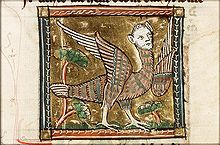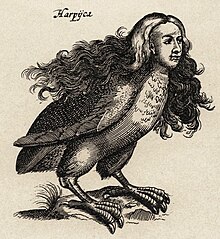Harpy (mythology)


A harpy eagle ( [harˈpyːjə] , ancient Greek ἅρπυια hárpyia "tear", Latin harpeia ) is a winged hybrid creature of Greek mythology in the shape of a bird with a woman's head.
mythology
The harpies embody the storm winds and are the daughters of the sea titan Thaumas and the oceanid Elektra . Their number is indefinite, but never more than two harpies are named at the same time. The following occur in particular:
- Aello ( Ἀελλώ Aëllṓ to ἄελλα áëlla "storm wind, eddy": " bride of the wind")
- Okypete ( Ὠκυπέτη Ōkypetē zu (poetic :) ὠκυπέτης ōkypétēs "fast flying", from ὠκύς okýs "fast" and πέτομαι pétomai "I fly": "the fast- winged ")
- Podarge, Podargo ( Ποδάργη Podargē "the fast- footed "). She is the mother of Achilles' horses .
- Kelaino, Celaeno (to κελαινός kelainos (poetic :) "dark", "ominous": "the dark one"), which is first mentioned in the Aeneid of the Roman poet Virgil .
The sister of the harpies is Iris , the goddess of the rainbow , wife of the west wind Zephyr .
In the earlier tales of Greek mythology, they are described as beautiful women with curly hair and bird wings, later they are ugly, light-haired demons. The harpies live in a cave on Crete and, at Zeus' behest, have to carry souls from the dead into the Tartaros or kill people who arouse his anger. The harpies are described as fast as the wind and invulnerable.
In Homer, they are held responsible for the disappearance of Odysseus and the quick death of the pandaro daughters. They play an important role in the saga of the Argonauts : They torture the blind seer Phineus by robbing him of food from the table and making it inedible with their excrement. Zetes and Kalais, sons of the north wind Boreas and companions of the Argonauts, finally drive away the harpies.
The Roman poet Virgil, on the other hand, recounts this fight in the Aeneid as an adventure of Aeneas, who fled from the destroyed Troy, on the stanzas : “They were birds with the faces of girls, the rubbish in their stomachs was extremely hideous, their hands were hooked and always Their faces pale with hunger. ”Aeneas also meets harpies in the lobbies of the underworld in Book 6, where they live next to gorgons and centaurs . In his Metamorphoses Ovid only briefly refers to the “virgin birds” in the Phineus episode of the Argonaut saga and sums up the adventure of Aeneas with the fact that the winged Aello (ales Aello) chases the Trojans from the verses.
Pictorial tradition
A famous monument of early antiquity in Xanthos , around 480 BC. BC, is named as a harpy monument , but this name is based on an interpretation of the harpy-like hybrid creatures on the reliefs of this tomb in Xanthos, which is now in doubt . Examples from Greek vase painting are the Phineus bowl in the antique collection of the Martin von Wagner Museum , as well as two bowls in the Villa Giulia in Rome .
Representations of harpies have been part of the symbolic realm of evil, the underworld and greed since the Middle Ages. They appear in drolleries of book illumination and building sculpture on the exterior of medieval churches, usually without a scenic context. They can hardly be distinguished from the perhaps less bird-shaped sirens . In the Renaissance, these beings are not only depicted in decorative contexts, for example in the framework of arabesques , but also in the context of ancient stories, such as in the frescoes of the Argonauts and Aeneissages by Annibale Carracci in the Palazzo Fava in Bologna .
In the 13th song of Dante's Inferno , the suicides are tormented by harpies. William Blake and Gustave Doré illustrated this scene in the 19th century. While for Goya in the Caprichos represent evil nor sinister incarnations are harpies in the crafts of classicism , much like the griffins and sphinxes , purely as a decorative motif reminiscent of the world of antiquity.
Harpies and falconers, painting on wood, 13th century, Llíria Archaeological Museum
Erasmus Quellinus II. , The Sons of Boreas Pursue the Harpies, around 1630. Prado
Calaïs and Zetes free Phineus from the harpies, engraving by Bernard Picart , 18th century
reception
A reception harpy happened in the literature and in the medium of film in the following works:
- In Shakespeare's The Tempest (1611), in the 3rd scene of Act 3, Ariel appears to the enemies of Prosperus in the form of a harpy.
- In the children's book Ronja Robber's Daughter by the Swedish writer Astrid Lindgren , wild dogs (also gray dogs ) are described as harpy-like creatures. In the film adaptation of the book, this aspect is clearly worked out: There these druids can be seen as clearly female hybrids with long hair, bills, wings and claws.
- In the trilogy His Dark Materials by Philip Pullman guard harpies the dead island wasteland. They are vicious and do not let the spirits of the dead calm down; they can see inside the spirits and recognize lies. Later they lose their evil and lead the spirits through the realm of the dead into another world - provided that the spirits give them their true life story.
- The harpy Celaeno also appears in the fantasy classic The Last Unicorn by Peter S. Beagle as a prisoner of the witch Mommy Fortuna, who she presents to the audience in her traveling circus. Ultimately freed from the unicorn, the harpy kills Mommy Fortuna and her assistant Rukh.
- In The Edge Chronicles by Paul Stewart , the harpies are a species of predatory birds humanoid beings who operate a slave market. They are depicted as oversized, violent birds of prey, but instead of real wings they have feathered arms.
- In Laura Leander by Peter Freund , the harpy represents a bird-like figure with the upper body of an old woman who gives off a pestilence-like stench. The being always tries to bring death and ruin, but ultimately always fails.
- In Heroes of Olympus , volume The Son of Neptune by Rick Riordan , harpies are bird ladies who torment King Phineas and are tormented by him. The harpy Ella loves books and befriends the demigods. It appears again in the next volume, The Sign of Athena .
- In the 1963 film Jason and the Argonauts , harpies attack Jason and his family (animation: Ray Harryhausen ).
- In the young adult novel The heart of the harpy of Rebekka Pax , the young Milena in love, in fact, a harpy, in a son of Thanatos , who is involved in an old bet.
- In the fantasy novels The Song of Ice and Fire by George RR Martin as well as in the TV series Game of Thrones based on it , the harpy as a presumably mythological figure is the symbol of the former empire of the Ghiscari and is still used by the slave cities.
See also

- Harpy (bird)
- Virgo eagle (harpies in heraldry)
as well as the hybrid creatures that can easily be confused with the harpies
literature
- Jan N. Bremmer : Harpies. In: The New Pauly (DNP). Volume 5, Metzler, Stuttgart 1998, ISBN 3-476-01475-4 , column 166.
- Sieglinde Hartmann: Harpy. In: Ulrich Müller, Werner Wunderlich (ed.): Demons, monsters, mythical creatures (= Middle Ages myths. Vol. 2). UVK, St. Gallen 1999, ISBN 3-908701-04-X , pp. 287-318.
Remarks
- ↑ Homer , Odyssey 20: 66-78.
- ↑ a b c d e Hesiod , Theogony 265-267.
- ↑ after Wilhelm Heinrich Roscher: Aëllopus . In: Wilhelm Heinrich Roscher (Hrsg.): Detailed lexicon of Greek and Roman mythology . Volume 1,1, Leipzig 1886, column 86 ( digitized version ). also Nikithoe or Aëllopus.
- ↑ Homer, Iliad 16,149 ff.
- ↑ Homer, Iliad 16,150 and 19,400. Zephyr fathered with Podarge Balios and Xanthos , the horses of Achilles, who are thus related to him, since Achill's mother Thetis as Nereid and daughter of the Oceanid Doris is the niece of the Oceanid Elektra . See also Virgil, Aeneid 3,210-255.
- ↑ Virgil, Aeneid 3,245.
- ↑ Virgil, Aeneis 3, 216-218; Hyginus Mythographus , Fabulae 14.
- ↑ Homer, Odyssey 1,241; 14.371.
- ↑ Homer, Odyssey 20: 66-78.
- ↑ Libraries of Apollodorus 1, 9, 21.
- ↑ Summary in Konrad Seeliger : Argonautensage . In: Wilhelm Heinrich Roscher (Hrsg.): Detailed lexicon of Greek and Roman mythology . Volume 1,1, Leipzig 1886, Col. 503-510 ( digitized version ).
- ↑ Virgil, Aeneid 3,210-255.
- ^ Translation of Virgil, Aeneis 3,215 by Rainer Lohmann: [1] ; Robert J. Rabel: The Harpies in the Aeneid. In: The Classical Journal. Vol. 80, No. 4, 1985, ISSN 0009-8353 , pp. 317-325, JSTOR 3296813 .
- ^ Ovid, Metamorphoses 7.3 f. and 13,709 f.
- ↑ Museum page on the object
Web links
- Entry on harpy at theoi.com (accessed May 30, 2019)





